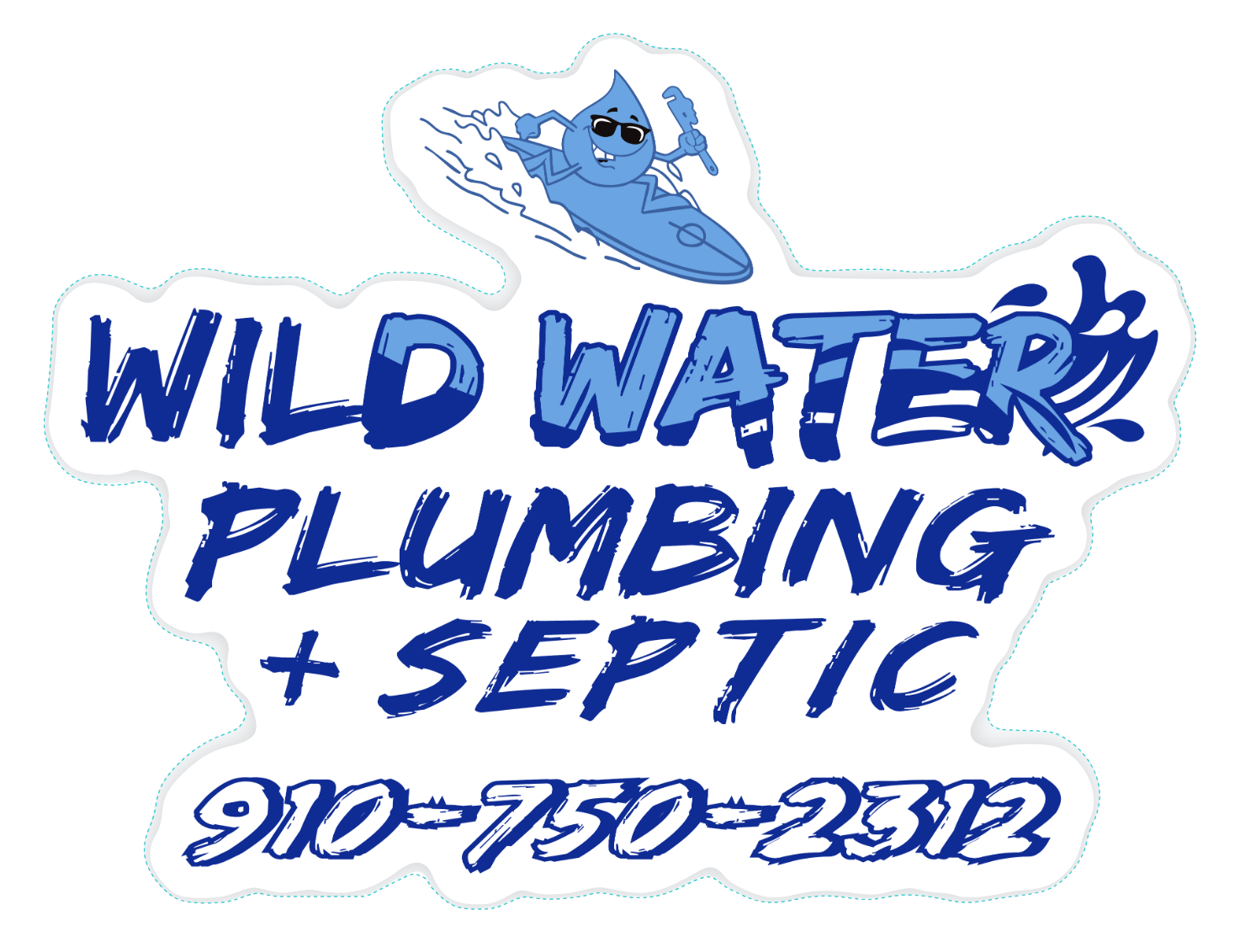Hi, I’m Justin Wilder, owner of Wild Water Plumbing here in Wilmington, NC. Living in or buying an older home in Wilmington can feel like a great investment – historic character, established neighborhoods, and lower purchase price.
But as an experienced local plumber, I’ve seen how decades-old systems can hide many problems.
Today I want to share the most common plumbing and electrical headaches I find in older New Hanover County houses, plus warning signs to watch for. My goal is to help you spot trouble early – after all, a small drip today can turn into a huge repair tomorrow.
Aging Pipes and Water Leaks
Old pipes = trouble. Many Wilmington homes built mid-century or earlier still have cast iron, galvanized steel, or even lead plumbing. Cast-iron sewer lines typically last 50–100 years, but corrosion often occurs much sooner.
Galvanized steel supply pipes (common pre-1980) usually only survive 30–40 years before they rust out. And homes built before the mid-1980s may have lead service lines or fittings – the Cape Fear Public Utility notes that houses built before 1986 “are more likely to have lead service lines or interior plumbing and fixtures”.
Over time, corrosion and minerals in Wilmington’s salt-humid climate can thin pipes, causing pinhole leaks or blockages. Even a tiny leak wastes a ton of water – the EPA estimates the average home loses about 10,000 gallons a year from hidden leaks.
A small drip here or a rusty faucet there may not seem like much, but leaks can rot wood, encourage mold, and skyrocket your water bill. For perspective, FEMA says just one inch of standing water in a house can cost up to $25,000 in damage.
Warning signs: Look for rusty or brown water, water stains on walls/ceilings, bubbling paint, or mold near plumbing.
Low water pressure throughout the house – or on just one side of the house – can hint that old pipes are clogged or corroded. Even hearing water running when faucets are off, or spikes in your water bill, can mean a leak somewhere.
If you have galvanized pipes, you might notice rust at joints or brown water when you first turn on a tap. At that point, it’s time to call a pro for a camera inspection – patching often isn’t enough when rust is inside the line.
Drain, Toilet, and Sewer Line Clogs
Clogged drains and sewers are another near-daily call I get. In the kitchen, I often find grease, cooking oil, and food debris baking on the insides of the old cast-iron or clay drain lines until the grease solidifies and stops the water. Bathroom sinks and shower drains slow or clog up from years of hair, soap scum, toothpaste and body oils. It’s normal for plugs and small drains to catch gunk – after a few months or years of use, what was once fast-draining can turn into a trickle.
Sewer line clogs are even nastier. Older homes in Wilmington often have sewer laterals (the pipe from the house to the street) made of clay, cast iron or Orangeburg (fiber-tar pipe used in the 1940s–60s).
These materials fail after about 50 years, with problems often starting around year 30. Tree roots will invade cracks in clay or Orangeburg joints, or completely collapse brittle Orangeburg pipe.
Experts say Orangeburg’s lifespan is only about 50 years, and by age 30 you can see deterioration. When a lateral fails underground, you may see multiple clogged drains at once, sewage backup, or sinkholes/greener patches in the yard. If multiple fixtures back up together or toilets flush very slowly, it could be a main sewer line issue.
Warning signs: Slow drainage (or gurgling noises) in multiple sinks, tubs or toilets? Bad odors from drains? Backups when flushing toilets or running the washing machine? This can mean a deeper clog in the main drain or sewer line. In Wilmington’s wet climate, large trees with aggressive roots often seek out leaks in sewer lines – watch for lush spots in your lawn or dimpling of the ground. A sewer scope inspection can confirm if your lateral is broken.
Old Fixtures and Faucets
Outdated faucets, shower valves and toilets are common trouble spots in older homes. Many pre-1990 fixtures haven’t been updated to meet today’s efficiency standards, and they wear out.
A dripping kitchen faucet that won’t stop, or a shower that only offers scalding or freezing water, are everyday annoyances I fix. Malfunctioning sink pop-up stoppers, corroded shower valves and leaking tub drains are standard.
A faulty or old toilet flapper can silently leak water from the tank to the bowl, wasting hundreds of gallons daily. Nationally, almost half of homeowners say they’d call a plumber first for a leaking pipe, and a running toilet is a top concern for 22% of them.
Faucets and shower heads themselves often crack or spin in place, and knob faucets can stick or snap off.
Outdated fixtures also lack modern safety features. For example, many older bathrooms and kitchens lack GFCI outlets, which the code requires for all areas near water. This is a shock hazard.
Warning signs: Mineral or rust stains around faucets and showerheads can signal corrosion inside. Brown or metallic-tasting hot water can mean a rusting heater or pipes. Toilets that run constantly, or look shaky on the floor, need attention.
Call a plumber if turning a faucet on immediately causes water to splash back or sputter. Replacing leaky faucets and worn flappers is usually cheap insurance: the EPA notes that small household leaks can waste thousands of gallons per year. Even swapping a cheap faucet aerator for a WaterSense-rated one can save about 700 gallons a year, so new fixtures pay off quickly.
Clogged Showers and Toilets
Shower drains get clogged mostly by hair and soap, similar to sinks – slowly shrinking the pipe’s opening. Older tile showers often have metal drains that rust out or separate, causing leaks under the floor.
Bathtubs with cast iron or old steel tubs can have corroded drain assemblies. I regularly clean out hair-clogging shower P-traps, but if it’s a root problem further down, it can keep coming back.
Toilets in older homes may also clog or fail. If the waste stack or soil line has settled or broken, toilets can flush poorly or leak at the base. Visible water pooling around a toilet base, or crumbling wax ring, means it likely needs replacement.
Also, older toilets pre-1990 use more water per flush; replacing them with modern low-flow models not only saves water, it reduces stress on the drain system.
Warning signs: If your shower or tub fills up while another drain is used, that’s a big sign of a shared-line clog. Toilets that constantly need plunging or gurgle after other fixtures run are in trouble. And if your air conditioner or washing machine back up onto floors, that can also tie to main drain issues. In all cases, don’t ignore recurring clogs – they often point to a larger blockage.
Severed Lateral and Sewer Line Breaks
In Wilmington’s old neighborhoods, severed lateral sewer lines are surprisingly common. A lateral can break or collapse underground due to root intrusion, ground shifting, or just old age (especially Orangeburg pipe, which tends to fall apart).
When this happens, multiple drains back up at once or nothing drains at all.
Homebuyers often find this during inspections. Repair usually means digging or trenchless repiping from the house to the street.
A ruptured lateral is expensive (often several thousand dollars), but delaying is worse: sewage can sink into your foundation or flood your yard. Watch for toilet and drain backups, or unusually wet soil near your foundation.
Many homeowners only realize they have a busted lateral when a camera inspection reveals a gaping hole or collapsed section. If your sewer was last replaced decades ago, it might be due for an upgrade.
Clogged HVAC (AC) Drain Lines
Don’t forget the AC. In Wilmington’s humid heat, air conditioners pull a lot of condensation. That water drains through a PVC line near your furnace. Over time, algae and mold can clog the line.
Water spills out of the pan under the AC coil when it clogs. In the summer I often get calls about mysterious water on basement floors or attics under window units – it usually turns out the AC drain is plugged.
Prevent this by pouring a cup of bleach or vinegar down the drain line once a year or having a professional flush it during HVAC maintenance.
A clogged condensate line won’t burst pipes, but it will shut off your cooling system and can cause water damage to ceilings or flooring.
Water Heater Woes (Electric & Gas)
Water heaters in older homes can be trouble, too. The typical electric or gas tank water heater lasts only about 10–15 years. After a decade, the tank interior rusts and sludge builds up. Common problems I see include pilot light or ignition issues on gas heaters, failing thermostats, leaky tank valves, or elements burning out on electrics. If your hot water suddenly stops, check your breaker or pilot first, but an old heater often needs replacement.
Gas heaters in older homes may also lack proper venting or a gas shutoff right at the unit. I always check that a gas water heater has a working gas shutoff and that the flue leaks properly.
Electric heaters require a dedicated 240V circuit; on an older 60-amp service panel, you may not even have enough capacity to run a new heater safely. A Home Inspector or electrician should verify that the breaker and wiring are appropriately sized.
One big plumbing tip: most electric heaters have a drip pan under them, but many old gas heaters do not. If a gas heater leaks, there’s no pan to catch it. Tar Heel Basement Systems notes that “in older homes, [water heaters] may not have the required drainage system to protect from leaks or overflows”.
So, if you have an older gas heater in a spot that would flood, consider adding a pan or moving it.
Electrical System Hazards
Switching gears: Electricity can be just as hazardous in older houses. In fact, national data shows electrical wiring issues are a top safety concern. An Insurance industry report (citing the U.S. Fire Administration) found that electrical fires are on the rise—up about 6% between 2013 and 2022.
Faulty wiring, overloaded circuits and outdated equipment contribute to this. Shockingly, about 30% of house fires involve electrical causes like malfunctioning appliances or wiring.
Older Wilmington homes often have outdated wiring that didn’t anticipate today’s loads. I often see homes with old 60-amp service panels (modern homes need 100–200 amps).
Flickering lights, frequent breaker trips, or dimming when big appliances start (like the AC or stove) are all red flags of an overloaded or aging panel. Look for warm outlets, discolored switch plates or outlets, or a burning/pisces-smell when appliances run.
These can mean loose connections or deteriorating insulation – precursors to fire or shock.
Many old homes pre-1970s still have ungrounded, two-prong outlets (and no GFCIs). Kitchens, bathrooms and basements should have ground-fault circuit interrupters by code, but older wiring often doesn’t. If you have an outlet near a sink or tub with no GFCI test button, that’s unsafe. It’s crucial to update outlets in wet areas or on underground circuits.
The Tar Heel Home Issues guide reminds us: “Older home wiring systems may not be up to current codes… [ensure] GFCI outlets in areas with water such as bathrooms and kitchens.” Ignoring it risks shock or worse.
Likewise, homes built in the 1960s might have aluminum wiring, which expands and contracts more than copper, loosening connections over time. If your panel or outlets have aluminum cable (look for “Al” stamped on switches), have an electrician inspect it.
Many insurers and builders recommend replacing aluminum or re-terminating it with special connectors, because homes with aluminum are far more likely to have electrical fires.
Warning signs: Buzzing sounds from outlets, a circuit breaker that won’t reset, or lights that flicker for no reason are definitely not normal. Also watch for “paralysis” breakers (ones that feel loose in the panel) and hot switches or dimmers. The Electrical Safety Foundation notes the average U.S. home is 37+ years old, with many electrical systems that “are no longer safe and may be considered fire hazards.” If you sense any trouble, schedule an electrical inspection.
Appliances: Sump Pumps and Water Softeners
Finally, remember that even “plumbing” appliances like sump pumps, electric water heaters and softeners are only as reliable as your electrical system. A sump pump can fail if its outlet trips a breaker or if it never had a dedicated circuit.
The same goes for electric water heaters – they need their own breaker. Water softeners (often requiring an outlet to recharge the salt valve) can malfunction if on an overloaded circuit. When I install pumps or heaters, I always recommend a dedicated, grounded circuit, often on a GFCI (in basements or garages).
In coastal NC, power outages can happen in storms – many homeowners install battery backup for the sump pump. If your home’s wiring is old or ungrounded, consider adding that to prevent basement flooding when the power blinks out.
Protecting Your Home and Next Steps
Older homes in Wilmington have charm, but plumbing leaks and electrical hazards will occur. The good news is that many problems show warning signs. Look for slow drains, rusty water, warm outlets, or high water bills, and get them looked at early.
As Mr. Rooter’s survey shows, nearly 1 in 3 homeowners call a plumber at least once every couple of years, often for leaks or pressure problems. You’re not alone, and help is just a phone call away.
If you discover any of these red flags, ring us. My team at Wild Water Plumbing is experienced in New Hanover County homes, from fix-ups in Carolina Place to beach houses on Figure Eight Island.
We can inspect your pipes (even with a camera), clear stubborn clogs, replace aging water heaters, and even coordinate with electricians for full-system upgrades. Our goal is to save you money in the long run by catching small issues now.
👉 Key takeaways: Regular maintenance is crucial. Flush your water heater yearly, have an electrician check old wiring, and swap leaky fixtures for WaterSense models to save water.
If you’re buying a home here, don’t skip the plumbing inspection – problems with leaks, rusty pipes or sewer lines are common in older Wilmington houses.
And whether you’re buying or living there now, at the first sign of trouble (drips, clogs, odd smells or sounds), give us a call.
We’ll make sure your plumbing and electrical systems keep your home safe and comfortable for years to come.
References
- Environmental Protection Agency (EPA). (n.d.). Household Leaks. Retrieved from https://www.epa.gov/watersense/fix-leak-week
- Federal Emergency Management Agency (FEMA). (n.d.). Flood Damage Costs. Retrieved from https://www.fema.gov/flood-damage-costs
- U.S. Fire Administration (USFA). (2022). Residential Building Electrical Fires. Retrieved from https://www.usfa.fema.gov/
- Cape Fear Public Utility Authority. (n.d.). Lead and Your Drinking Water. Retrieved from https://www.cfpua.org/faq.aspx?QID=240
- Mr. Rooter Plumbing. (2021). Homeowners Survey: Top Plumbing Concerns. Retrieved from https://www.mrrooter.com/blog/
- Tar Heel Basement Systems. (n.d.). Common Plumbing Problems in North Carolina. Retrieved from https://www.tarheelbasementsystems.com/
- National Association of Home Builders (NAHB). (2019). Age of Housing Stock in the United States. Retrieved from https://www.nahb.org/
- National Fire Protection Association (NFPA). (2022). Home Structure Fires. Retrieved from https://www.nfpa.org/
- U.S. Census Bureau. (2022). American Housing Survey. Retrieved from https://www.census.gov/
- Electrical Safety Foundation International (ESFI). (2022). Home Electrical Safety. Retrieved from https://www.esfi.org/


